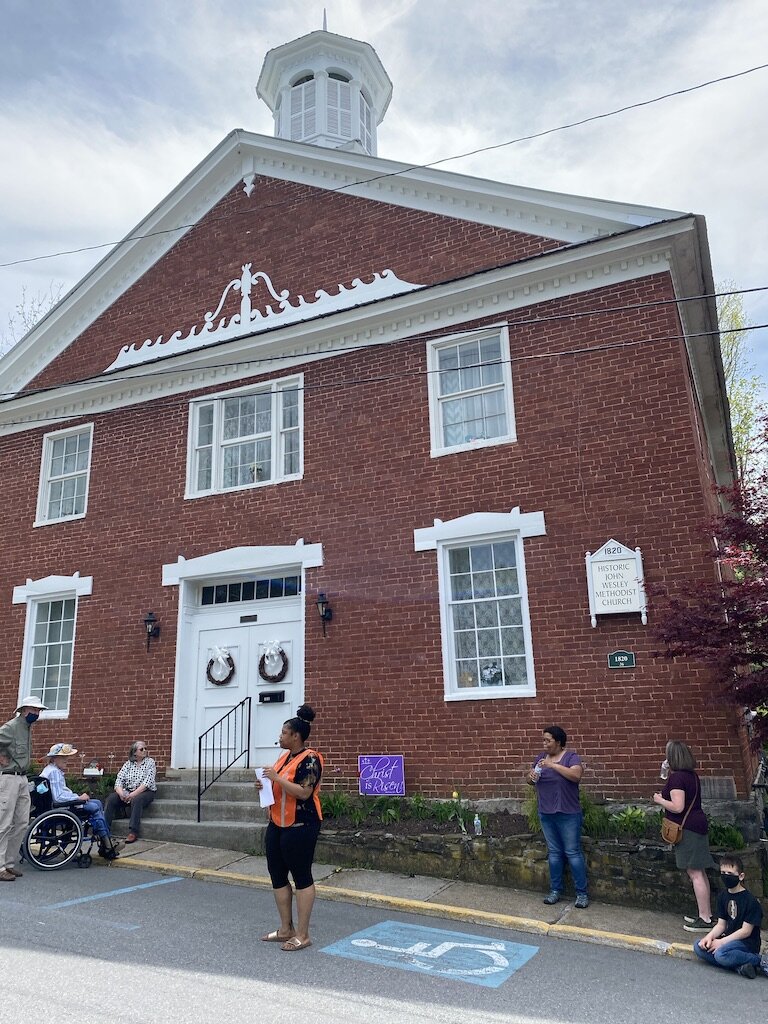Sharing Diverse Histories at the Greenbrier Historical Society

By Sally Bray
Learning one’s history, really understanding one’s roots, often takes courage. And resources. By accepting the circumstances that define us and our community we learn from the past, and, with a little bit of luck, create a better future.
Luckily for Greenbrier Valley residents we have a resource just up the hill on Main Street and a hard working, courageous team that has done a lot of digging into our history to create exhibits that are very educational and easy to access. Enter the Greenbrier Historical Society (GHS).
It’s an understatement to say that the history of West Virginia, in general, and of Greenbrier County, specifically, is complicated. It’s passage to statehood was strife-ridden. Called the orphan state, the mountain state, and the state born of rebellion, the 35th state of the United States came to be because of irreconcilable differences with Virginia and the Confederacy around slavery. While “New Virginia”--as West Virginia was originally labeled--supported the Union, Greenbrier County was known to be sympathetic to the Confederacy.
So why did Greenbrier County stay with the Union and not secede with Virginia? The defining reason that this Valley was part of the secession from Virginia was because of its topography, rather than its philosophy around human rights and slavery. The rugged Appalachian Mountains provided a strategic physical barrier between the Confederacy and the Union, and thus, Greenbrier County became part of the Virginia-West Virginia split in 1861. Despite being part of the country’s Union states, Greenbrier Valley remained complicit in the institution of slavery, adopted Jim Crow laws, and upheld segregation.
This context is important when we learn about the struggles that African American residents endured during the Civil War and beyond. Greenbrier Historical Society's Black History Walking Tour and the North House’s (home of the GHS) new exhibits bring to life some of the challenges Black townspeople endured even after the Civil War, and highlights many successes that resilient Black business owners achieved despite the strife in Greenbrier Valley during the late 1800’s.
Brehana Scott, tour guide, stops in front of John Wesley Methodist Church, one of the 17 stops along the Black History Walks Tour.
Black History Walking Tour
On Sunday May 2, 2021 the Greenbrier Historical Society kicked off a series of guided walking tours that led visitors on a one mile walk of downtown Lewisburg where they learned about the vast Black history of the town. These docent-led tours are ongoing, and may be scheduled by calling the Greenbrier Historical Society; price for the tour and admission to the Museum is $10 per person. The 45 minute tours include a one mile walk (wear comfortable shoes) up and down the rolling hills of downtown Lewisburg and begin and end at the North House (814 Washington Street, West).
The Black History Walking tours are made possible by generous donations from the Herbert Henderson Office of Minority Affairs (Charleston, WV) and Wooton, Davis, Hussell, Johnson Law Firm (Lewisburg, Beckley, and Charleston, WV).
Lewisburg’s Historic African American Business Owners:
The tour visits 17 historically Black business buildings and churches and teach visitors about the people who inhabited these places. Here are just a few of the tour highlights:
Mildred Bess’ Fortune Telling Shop - currently Flanagan’s Barbershop (971 Washington St., W.)
Mildred Bess Carter (b. 8/1895 – d. 1985) was the daughter of Ed Carter, a Black barber in Lewisburg. She was a well-known clairvoyant recognized for telling fortunes and helping people find items. When her father died she inherited his building and lived upstairs. Guests at the Greenbrier Resort and students from the Greenbrier College would come to Bess to get their fortune told. She did not advertise her psychic abilities because she thought that would cheapen her gift, but she was known all over the county. Legend has it that Mildred had a gravestone as décor in her home, and that she had predicted her death date.
Anthony Carter’s Cobbler Shop -currently GV Visitor Center Building
(intersection of Court St. and Washington St., corner facing Court St.)
Anthony Carter, his wife Fanny, and their three children were enslaved by Henry Erskine until July of 1837. Two years after emancipation Anthony became a cobbler and rented basement space beneath various shops downtown. Less than a year after emancipation Anthony was summoned before the court to defend his family’s right to remain in the county. Since 1806 Virginia law mandated that any freed Black person was required to leave the state unless granted special permission. Even with approval to stay, Anthony was brought before the court multiple times between 1838 and 1842. Despite this harassment, he continued to work and make payments to purchase an acre of land just east of Lewisburg for his homestead.
Brehana Scott, Marketing Manager of The Greenbrier Historical Society, in front of The Life and Work of Anthony and Fanny Carter exhibit at The North House Museum.
Calendars Restaurant – currently Edith’s Health & Specialty Store
(1035 E. Washington St.)
Nancy Perkins Calendar (b. April 12, 1842 - d. April 9, 1926) and her husband, James operated a restaurant in a building owned by Sally Patton. They paid Patton $20 a year and opened the restaurant between 1887 - 1888; when Patton died in 1892 her property was auctioned off to pay her debts. According to family history, townspeople believed that Calendar was entitled to the property and her bid of $50 was uncontested. Although born into slavery and illiterate, Calendar managed the restaurant. She purchased eggs and fresh vegetables from local farmers and ordered oysters and fish from Baltimore, MD. In its truest definition, she ran a farm-to-table restaurant until her death in 1926. In a wonderful twist of fate, Lindsay Jones is the current Black business owner of Edith’s Health Specialty Store, in the same location as Calendars Restaurant. Jones, a Lewisburg native, has worked for Ediths’ Health & Specialty Store for twenty years, and has owned the business the last two, since 2018. “It was just a natural evolution from working here to owning the business,” said Jones. “I’ve always been interested in herbs and natural medicine.” As one of the few African American business owners in Lewisburg Jones said, “I really feel at home here, and welcomed.” Jones continued, “This is a very powerful time to be a Black business owner in Lewisburg.” Jones was referencing the support she feels in the community, evidenced by Lewisburg having its first Black mayor, Beverly White. Beverly White is also a native West Virginian and is a descendant of Nancy Perkins Calendar of Calendars Restaurant. Jones is thriving in our community, and has just won the Greenbrier Historic Society’s 2021 Local Business Person of the Year award. Winners were singled out for going above and beyond to help peers and their communities power through the COVID Era.
North House, home of the Greenbrier Historical Society
The Greenbrier Historical Society (GHS) has proudly called The North House home since 1975. The beautiful brick house, located at 814 Washington Street, overlooks downtown Lewisburg. It was built in 1820 and John and Charlotte North were the first inhabitants, and are the namesakes of the house. Its 200 year history has been very well documented by the Greenbrier Historical Society. The current Executive Director, Nora Venezky; Marketing Manager, Brehana Scott; and Sarah Shepherd, Archives Associate, are busy working on two new exhibits: Wagon House exhibit (opening May 29) and Star Hotel Tavern Room (opening in July). “Nora, Brehana and Sarah have done a tremendous job creating interesting and accessible exhibits,” said Cooley. “The three-dimensionality of the exhibits really brings our history to life, and creates an eye opening experience.”
Museum Docents are available Tuesday - Saturday, 10 a.m. to 4 p.m.; GHS is closed Sunday and Monday. You may also choose to wander through the house and exhibits and take in the rich information at your own pace. Museum guided tours cost $5; donations are accepted for self guided visits.
North House Exhibits:
Echoes of Slavery in Greenbrier County Exhibit
The first enslaved person stepped onto American soil in 1619 beginning a system of enslavement that would last for nearly 250 years. The United States would not exist without the contributions of a group of people that were defined by the color of their skin. African Americans were the basis of an economic system on which the wealth of a nation was built. Slavery was replaced with a series of laws and social codes that prevented African Americans from enjoying basic human rights. The legacy of oppression and its effects on American society are still felt today. This resilient group of people who faced cruelty and dehumanization, also show a history of resistance and perseverance by fighting for their freedom, rights, and humanity. View the virtual exhibit here: https://www.greenbrierhistorical.org/echoes-of-slavery-in-greenbrier-county.html
The Life and Work of Anthony and Fanny Carter Exhibit
The discovery of business papers and daybooks, dating from 1833 to 1844, shed light on an unexpected character. Anthony Carter was a freed Black businessman of Lewisburg. We know Anthony as a husband, a father, a cobbler, and a landowner through studying his papers and Greenbrier County court records. These resources allow a rare glimpse into a freed working-class Black family’s determination to thrive in a slaveholding society. View the virtual exhibit here: https://www.greenbrierhistorical.org/the-life-and-work-of-anthony-and-fanny-carter.html
Fanny Carter worked to support her family, and as a laundress she sometimes brought in more money than her husband. By 1839, Anthony and Fanny were able to earn enough money to purchase an acre of land just east of Lewisburg. These successes were achieved in spite of struggles including multiple orders for the family to appear in court and the death of Anthony at 47 in 1844.
Black History Walks tours are available throughout the summer. Call the North House Museum (304-645-3398) to book a tour or request more information.






